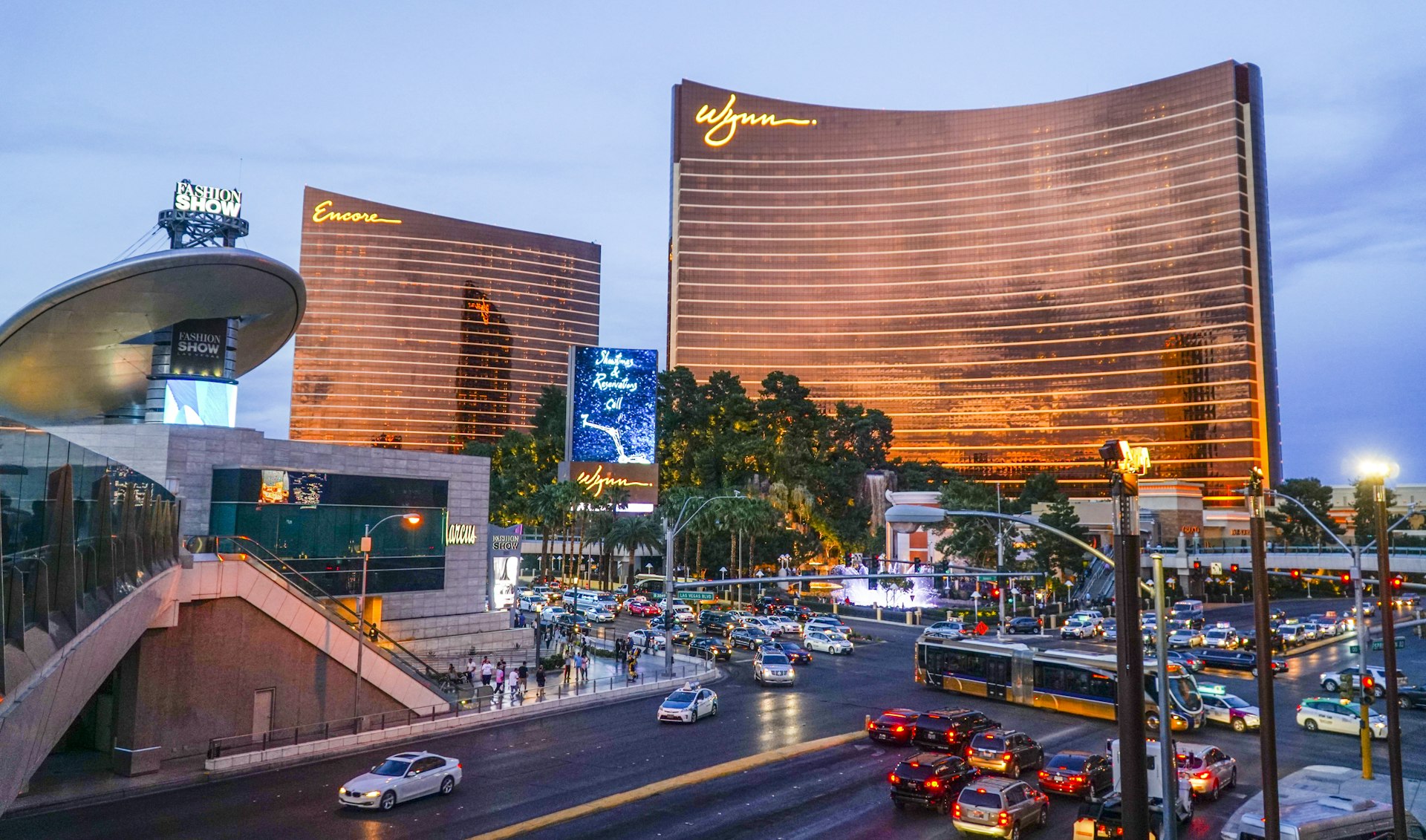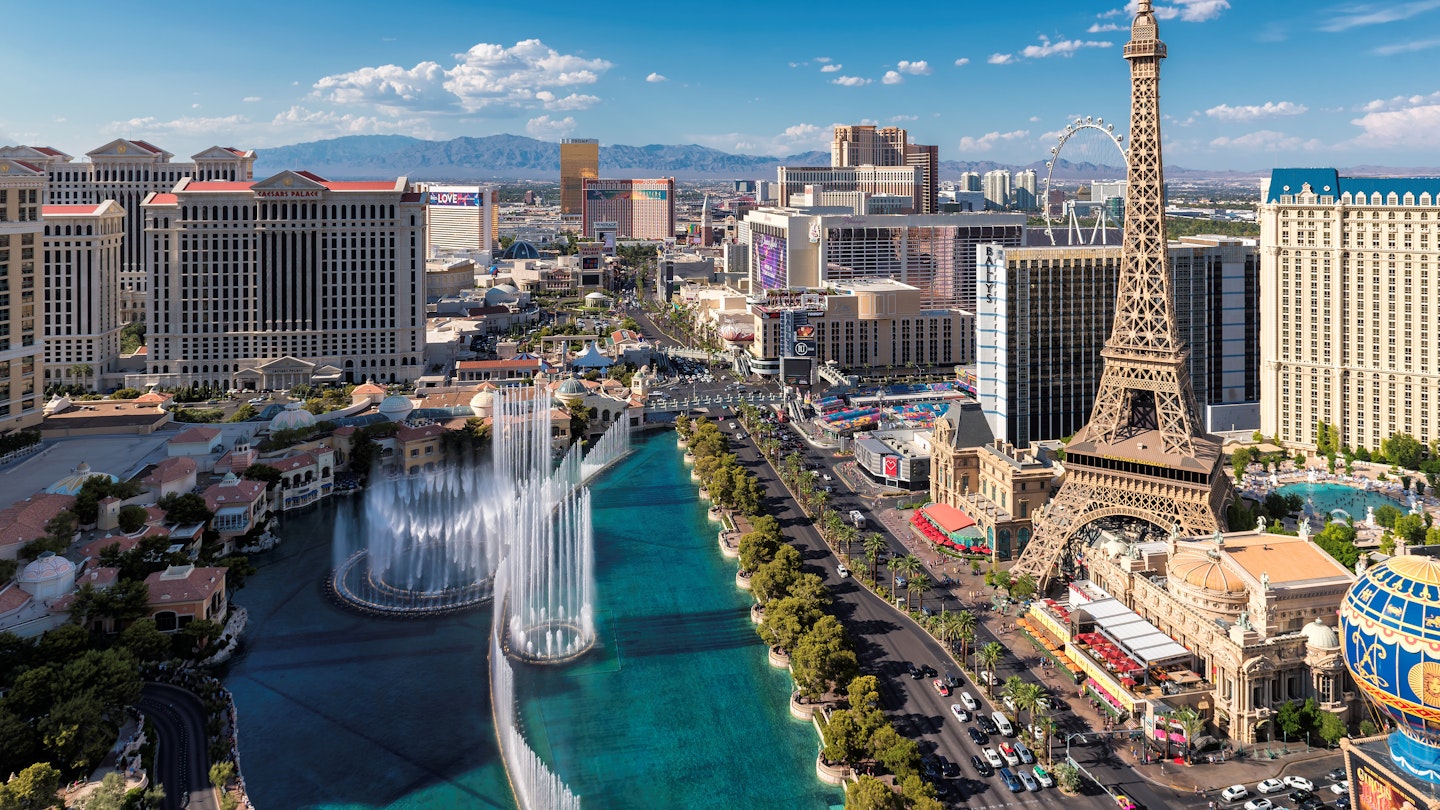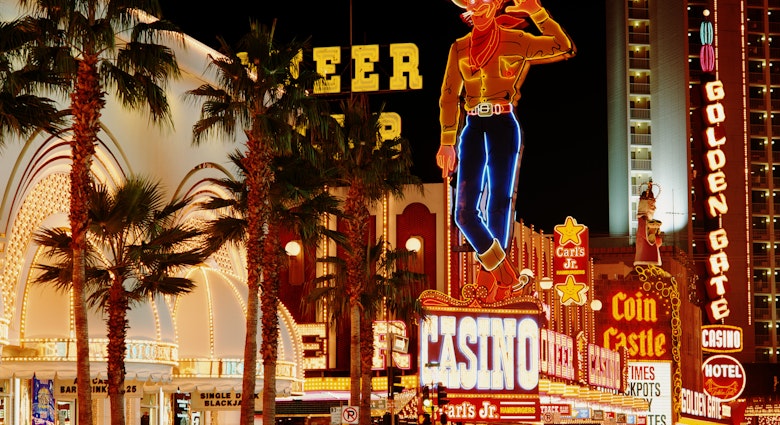Rolling into Vegas behind the wheel as a Sin City first-timer is a classic experience – arrive after dark and approach from the south for maximum “wows” and the iconic Welcome to Las Vegas sign. Next, cruise the 4.2-mile section of Las Vegas Blvd between Russell Rd and Sahara Ave, known as “The Strip.” Take in Luxor's glowing beacon, New York–New York's Statue of Liberty, Bellagio's dancing fountains, Paris' Eiffel Tower, Mirage's erupting volcano and the gleaming beacon of the Stratosphere Tower.
Here’s everything you need to know about getting around once you arrive in Vegas.

Walking
While walking might work for short distances, keep in mind that The Strip is more than 4 miles long. Don't assume you can walk easily between casino hotels, even those that appear to be close together.
Bicycle
Cycling is a great way to get around downtown, and (albeit clunky) bikes are available at inexpensive rental pods through the Regional Transportation Commission of Southern Nevada. Technically, you can ride between downtown and The Strip or other outlying neighborhoods, but we don't recommend it due to distance, heat and the general lack of cycling infrastructure.

Bus
RTC buses operate from 5am to 2am daily, with popular Strip and downtown routes running 24/7 every 15 to 20 minutes. Double-decker Deuce buses to/from downtown stop every block or two along The Strip. Quicker SDX express buses stop outside some Strip casino hotels and at the Fashion Show, the city's convention center and a few off-Strip shopping malls.
Two-hour passes are $6; 24-hour passes are $8; and 3-day passes are $20, with reduced fares for seniors, veterans, children and people with disabilities. Have exact change when boarding or purchase passes on board Deuce vehicles, at select ticketing vending machines or on the rideRTC app.
Many off-Strip casino hotels offer limited shuttle buses to/from The Strip, usually reserved for hotel guests (sometimes free, but a surcharge may apply).
Car
Driving on The Strip can be stressful. Locals are known for driving carelessly and crashes on interstate approaches are commonplace, as are drunk drivers. Keep your wits about you.
The golden days of free self-parking (and sometimes even valet parking) at Strip casino hotels and shopping malls are over. Locals and tourists alike might be up in arms about what can add up to significant additions to your Vegas vacation bill (depending on where you're staying and for how long), but paid Strip parking seems here to stay. Rates vary by property, but the paid-parking roll-out is across the board.
Check here for an up-to-date list of the latest rates.
Tips for driving in Las Vegas: Pedestrians legally have the right of way at all times, even if they're crossing illegally. Drivers must stop for pedestrians at crosswalks. Beware of jaywalkers – many people are hit while crossing the street.
If you are involved in an accident, dial 911 for emergency police, fire and ambulance assistance.
The blood-alcohol limit over which you are considered legally drunk is 0.08%. If you're not sober enough to drive, call Designated Drivers Inc to pick you up and drive your car back to your hotel; fees vary by mileage.
Monorail
The Las Vegas Monorail links some Strip casino resorts, zipping between MGM Grand, Bally's/Paris, Flamingo/Caesars, Harrah's/LINQ, Las Vegas Convention Center, Westgate and SLS. Although service is frequent (every 4 to 12 minutes), stations are only on the east side of the Strip, set back from Las Vegas Blvd at the rear of the casinos served. On the plus side, air-conditioned trains are stroller- and wheelchair-friendly, and it takes just 13 minutes to travel the entire route.
One ride is $5, with 1- to 7-day passes ranging in price from $13 to $56.
Shuttle
Many off-Strip casino hotels offer limited free shuttle buses to and from The Strip, although some are reserved for hotel guests. Conveniently, free public shuttles connect the Rio with a couple of its sister casino-hotel properties on the Strip – Harrah's and Bally's/Paris Las Vegas – usually every 30 minutes from 10am until 1am daily.
Bell Trans Airport Shuttle is a reliable paid shuttle service.

Taxi and limousine
It's illegal to hail a cab on the street. Instead, taxi stands are found at almost every casino hotel and shopping mall. By law, the maximum number of passengers is five. All companies must have at least one wheelchair-accessible van, but you'll usually have to call ahead and then wait.
Vegas is surprisingly compact, so taxis can be reasonable on a per-trip basis. A lift from one end of The Strip to the other, or from mid-Strip to Downtown, costs at least $20, depending on traffic. Tip the driver 10% to 15%, rounded up to the nearest dollar. Not all taxis accept credit cards (cash only), so ask when getting in. Check here for more information on hiring a taxi when in Vegas.
For special occasions or stepping out in style, some parties will hire a limousine. Popular companies include Presidential Limo. Hourly rates start at around $45 for a town car and go up to $125 for a 14-passenger Super Stretch Hummer H2 Limo with a complimentary champagne bar. Rent a party bus seating 20 for $175 an hour.

Tram
Free air-conditioned trams that anyone can ride shuttle between some Strip casino hotels. One connects the Bellagio, CityCenter and Park MGM. Another links Treasure Island and the Mirage. A third zips between Excalibur, Luxor and Mandalay Bay. Trams run all day and into the evening, usually stopping from late-night until the early morning hours.
Accessible travel
Vegas has the most ADA-accessible guestrooms in the USA. Almost all attractions are wheelchair-accessible. Wheelchair seating is widely available and assisted listening devices are offered at most showrooms. Most public transportation and several hotel pools are lift-equipped. By law, all taxi companies must have a wheelchair-accessible van. If you're driving, bring your disabled-parking placard from home.
Guide dogs may be brought into restaurants, hotels and businesses. Some payphones are equipped for the hearing-impaired. Most banks offer ATMs with instructions in Braille and earphone jacks.
Download Lonely Planet's free Accessible Travel guides for more useful information.











